Today I’d like to talk about that delightful little companion of field and garden: the shrike.

[copyright Rosemary Mosco, 2024, birdandmoon.com]
If you know, you know. And if you don’t know… well, let’s talk about shrikes.
Shrikes are a group of birds found across the tropics and the northern hemisphere. There are about 30 species, which means they’re a reasonably successful group. They’re a sister clade to the Corvidae — the crows, jays, and ravens — and like their corvid cousins, they’re pretty bright. Today’s paper is about loggerhead shrikes, which is the little guy in the cartoon above. (The cartoon is very accurate; Ms. Mosco takes her bird art seriously). But it applies generally to most species of shrike.
So let’s go to the obvious bit first: shrikes are sometimes known as “butcher birds”. This is because of their strange and rather gruesome habit of impaling their prey on thorns or sharp branch-ends.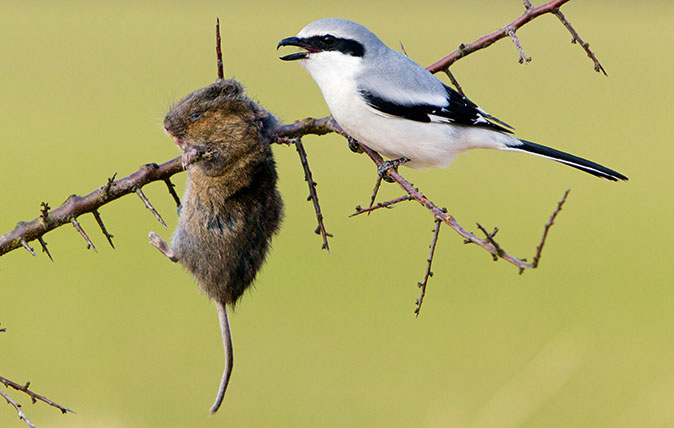

Shrikes of all species and both genders do this, because it’s a way to store food safely. (It’s basically the same strategy that a leopard uses when it stashes a dead antelope ten meters up in a tree.) However, in several species the male shrikes take it further and will decorate a particular bush or tree with dozens of little corpses — mice, large insects, small birds — as a display to impress and attract females.
Okay, that’s strange and interesting. But while it’s the thing most people know about shrikes, it’s far from the strangest thing about them. Shrikes are much weirder than people realize.
Let’s start with something so obvious it gets overlooked. Look at those photos. The shrike is a predator, right? It’s a pure carnivore, eating nothing but meat and flesh. Its entire diet is large insects and small vertebrates: mice, frogs, lizards, snakes, and other birds.
What do we expect a predatory bird to look like? Well, normally we expect it to look something like these guys:
Okay, those are big and shrikes are small. So, what do we expect a small predatory bird to look like?

Despite their differences, these guys are all very obviously birds of prey. They all have hooked beaks for tearing flesh, forward-facing eyes, and — this is key — they all have large, powerful talons. And those talons are absolutely crucial! They use those sharp, strong claws for gripping, for killing, and for dismembering their prey.
Now look at the shrike. It has a slightly hooked beak, its eyes are only somewhat forward-facing, and it has no talons whatsoever. It’s hopping around on pretty ordinary little bird feet, not much different from a common thrush or sparrow.
Okay so: why doesn’t it have talons? And without talons, how does it manage to capture, kill and dismember its prey?
Well, the shrike has evolved its own, very strange mode of predation. It’s not a pursuit predator, like a wolf; nor an ambush predator, like an owl or a cat; nor even a speed predator, like a hawk or a cheetah. No. The shrike is a deceit predator, and it uses a strategy that is completely unique among birds.
Let’s start with its appearance. The shrike looks like a harmless songbird. In fact, it looks like what birders call a “Little Brown Job” — meaning, one of the dozens of species of small-to-medium-sized brownish or greyish songbirds without much color or any distinguishing characteristics.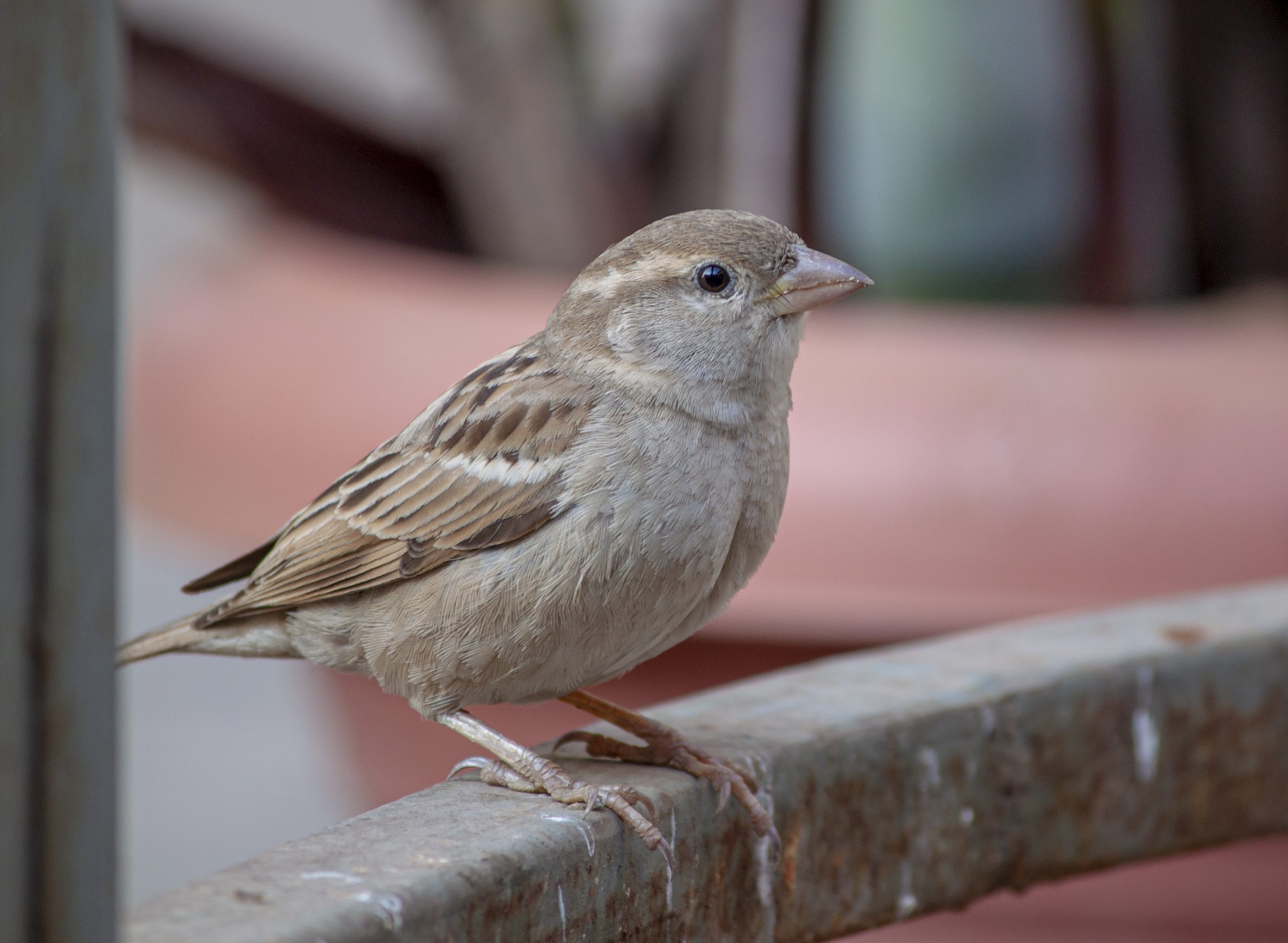

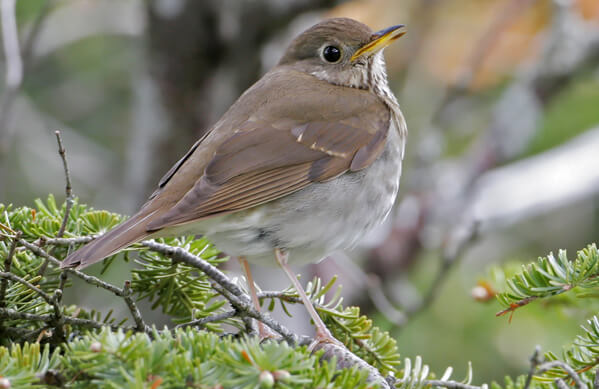


[all images public domain]
Can you spot the killer in this lineup?
— And here’s a thing: the shrike is, in fact, a songbird. It’s not related to hawks or falcons at all. Its remote ancestor was probably something like a small jay or magpie. But while other songbirds evolved to hop around and eat seeds and little bugs and whatnot, the shrike went a different route.
Because, you see, the world is full of Little Brown Jobs. Sparrows and chickadees, thrushes and tits, flycatchers and warblers and wrens: they’re all small, they’re mostly spotted or striped white and grey and brown, and they’re all harmless to anything larger than a beetle. So animals of all sorts — frogs and mice, small snakes and lizards, newts and shrews and of course other birds — have evolved to ignore Little Brown Jobs.
Because if you’re a mouse or a lizard or a sparrow or some other small prey animal? And you freak out every time a harmless chickadee or nuthatch comes near? You’re going to quickly die of sheer stress, because Little Brown Jobs are everywhere. You can’t be fleeing for cover at every pipit or junco. You have to do threat assessments. You have to filter.
And that cognitive-perceptive filter is where the shrike makes its living. It has evolved to look just enough like a harmless songbird that it doesn’t trigger any avoidance reflexes in potential prey.
But this introduces some problems. As we all know, one of the triggers for prey is the distinctive silhouette of a raptor. That’s why those hawk-shadow cutouts work to warn birds away from glass, and it’s why a fake owl makes a great scarecrow.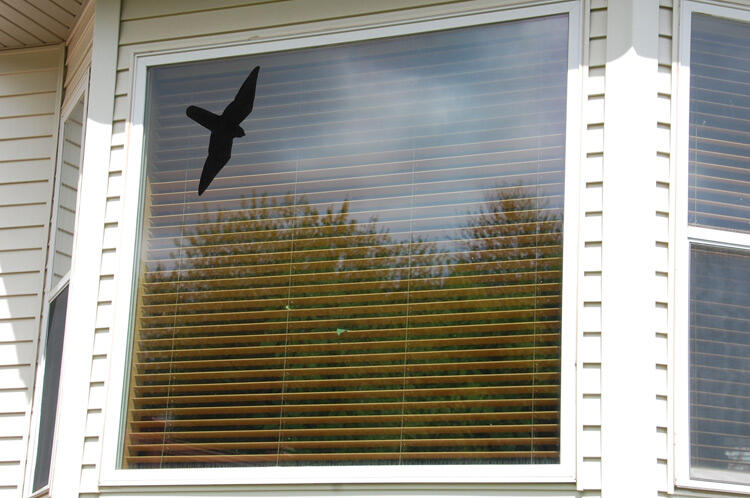

But another trigger is… talons. Studies have shown that a bunch of different prey species will flee or hide in the presence of a bird that has talons.
So the shrike doesn’t have talons because it can’t. Talons would completely blow its cover. But without talons, how then does the shrike kill its prey?
Put a pin in that, because there’s one more freaky thing about the shrike.
“She will stand at perch upon some tree or poste, and there make an exceedingly lamentable crye and exclamation…all to make other fowles to thinke that she is very much distressed and stands in need of ayde; whereupon the credulous sellie birds do flocke together at her call. If any happen to approach neare her, she…ceazeth on them, and devoureth them (ungrateful subtill fowle) in requital for their simplicity…”
— That’s from The Boke of St. Albans, a 15th century treatise on hunting and falconry. And it describes the shrike using what scientists call an “acoustic lure”.
Because shrikes don’t just look like songbirds. They sound like them, because they mimic their calls. The shrike’s default call is a harsh little shriek, like a jay’s call but higher pitched. (Hence the name. Shriek, shrike.) But they’re not restricted to that call, because they’re also excellent mimics. And they will very deliberately mimic other birds in order to lure them close. They start with distress calls, presumably because those are easiest. But older and more experienced shrikes can expand their repertoire to include territorial challenges and mating calls.
When I described this to an academic friend, he cried out “It’s a monster from folklore!” And it kind of is, right? The voice from the forest that calls out for help, or that sings a song that’s seductive and sweet? But don’t you go there… Yes, if sparrows could talk, the shrike would be their Dracula, their Grendel.
Acoustic luring is rare among land vertebrates, but it’s not unknown. Most famously there’s the margay, a South American jungle cat, that can mimic the distress calls of baby monkeys.

The shrike’s cousin, the jay, also mimics the calls of hawks — though apparently it does this, not as an acoustic lure, but defensively, to protect its territory and drive away competitors. Jays have been observed using hawk calls to clear a bird feeder for themselves.
But okay: the shrike gets close to prey by looking harmless and sounding harmless, and it can even lure other birds with fake calls. But now that it’s up close… with a relatively small beak and no talons, how does it actually kill its prey?
Well, we used to think we knew. Let’s look again at our little friend: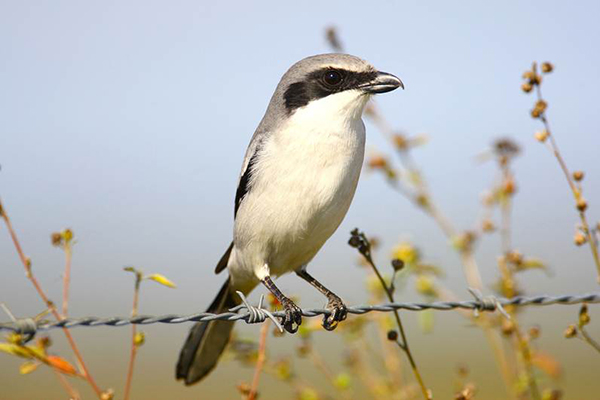
[Neighbors said he was quiet and kept to himself]
It doesn’t have talons. And it doesn’t have a massive beak like a hawk or an eagle, either. But its beak does have that little overhanging “tooth” at the end. And its head is rather big for its body, and its neck is quite thick. From a certain angle, it almost looks a bit hunchbacked. What’s going on with that?
Well, what we saw was that the shrike would often begin its attack with a sudden sharp peck, always delivered to the prey’s head or neck. So it was assumed that this was the killing blow, presumably severing the spinal cord. The shrike would then grab the prey, give it a shake, and fly off. When vertebrate prey items were examined post-mortem, sure enough, the spine was severed.
(By the way: the impaling on thorns? This is how shrikes dismember their prey without talons. They evolved to use a tool, the thorn, as a utensil. Using it as a larder, and then as a sexual display, presumably evolved later.)
Okay so that seemed to make sense, except… even with disguise and luring, killing your prey with a single very precise blow seems like kind of a tall order. Also, while the shrike’s beak is sharp and strong, it didn’t seem quite the right shape for a deep severing blow. And further, while the shrike would often start with the peck, sometimes it would skip it and go straight to grabbing and shaking.
Which brings us at last to the paper. These guys captured shrikes, gave them various prey items, and then took video of the attacks. And what they discovered was: the peck is not the killing blow. The peck, a sharp strike to the head or the back of the neck, is just the setup. It’s done to stun and disorient the victim, just for a second or two. But it’s not what kills the prey.
What kills the prey is the shaking. The shrike’s strong, hooked beak isn’t designed to kill with a blow. It’s designed to stun with a blow, and then to clamp down strongly on the prey’s neck while the shrike shakes it. The shrike’s thick neck? Is because the shrike has massively powerful neck muscles. The shaking can deliver sudden accelerations of up to six gravities in a fraction of a second, which is roughly like having a 50 pound weight quite suddenly dropped on your neck from a yard up. It’s the shaking, not the peck, that severs the prey’s spinal cord. The shrike suplexes its prey to death.
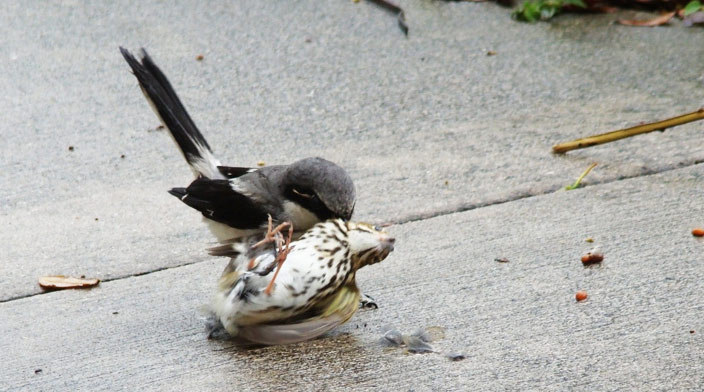
[yes strictly speaking this is a rear naked choke not any kind of suplex, don’t @ me.]
What triggered this post: I saw a shrike in our garden recently. And it was shaking a prey item — a small snake, I think — and also slamming it against a tree. (They do that, too.)
Like a lot of carnivores, shrikes are fiercely territorial. So if our garden is part of its territory, it’s probably been around for a while. But I never noticed it. Until I saw it in the actual act of killing, my brain just processed it as another nondescript small dull-colored songbird, not very interesting.
And it’s not just me. If you live in the northern hemisphere, and not in a large city, you’ve almost certainly seen a shrike. They’re not particularly rare! But you probably didn’t notice it, because not being noticed is exactly their thing.
Anyway. Shrikes can live a decade or more, getting more experienced and more cunning all the time, harder to spot yet also more convincing in their mimicry and lure. (“Like a Master Vampire!” said my academic friend.) So good chance that little guy is still out there, hopping around, looking and acting and sounding like a harmless little songbird… until.
I hope so.
{ 22 comments }
Phil 03.25.25 at 9:41 am
Apparently British birds are wise to the sneaky little so-and-so: “Shrikes are often ‘mobbed’ by other birds who recognise them as dangerous predators.” (RSPB). The accompanying map also suggests I’m fairly unlikely to see one, sadly.
SamChevre 03.25.25 at 12:51 pm
There is one more characteristic of predatory birds that the shrike is missing – the big, binocular eyes. And that’s another thing that every prey animal fears – even in mammals, binocular eyes go with predators.
I learned a lot about this when my 6-year-old needed vision therapy. Binocular eyes are expensive – it takes a lot of brain and muscle development to make them work right. And they reduce your field of vision. And so if you don’t need them, they’re selected against-but if you are a predator, they are valuable.
Chris Heinz 03.25.25 at 12:58 pm
2 years ago we had a shrike nest in a large clusia bush behind our house, Naples FL.
4 years ago we had a shrike nest in a live oak. That year, 1 day I observed a shrike pecking furiously at a small hibiscus tree, wood chips flying. I went out to see what was up a few hours later & found a lizard impaled on the broken-off branch that the shrike had sharpened (I have pix). They ate 1/2 the lizard that day, the next day there was just the bloody sharpened branch. So not just tool use, tool creation.
Their songs are generally 1-3 note, repeated for a few minutes, then changing.
Chris Heinz 03.25.25 at 1:04 pm
We used to have a Jack Russell terrier. Terriers also kill their pray (rodents) by shaking vigorously to break the neck. My daughters thought it was so cute how vigorously he would shake a rope that they would tug-of-war with him until I told them that.
Doug Muir 03.25.25 at 1:09 pm
@1 Phil, yes, sometimes the disguise breaks down! It’s not clear why, but one possibility is that the mob victims are young shrikes who are still learning the finer points of mimicry and deceit.
Also, if the shrike is Dracula, this is a mob of peasants with torches, storming the castle…
@2 Sam, yup. If you look closely, the shrike’s eyes are slightly forward-facing… but apparently just not enough to trigger alertness or fear in prey.
Doug M.
Doug Muir 03.25.25 at 1:11 pm
@3 Chris, that is damn interesting! I haven’t seen anything about that in the literature. But it makes perfect sense — not everyplace will have conveniently located thorn bushes!
In all seriousness: consider sending this to a local bird group or ornithologist. Yes, it’s just an anecdote, but anecdotes point the way towards real research, and a surprising lot of bird research is done by low-budget amateurs.
Doug M.
Dave 03.25.25 at 6:52 pm
Love this!
Matt 03.25.25 at 10:06 pm
The Australian Butcherbird is, it seems, not closely related to the ones in question here, but, according to wikipedia, “are the ecological counterparts of the shrike.” They do have similar hooked beaks. They are more closely related to the Australian magpie (which is again not that closely related to the Eurasian magpie.) Here, they seem to mostly eat insects and small lizards (having few small mamals to eat, perhaps.) We have several that live near us, and the other day, while having morning coffee on the deck, a family (I think) came up to us and took some bits of bread. They refused some bits of fig, though, so I guess there is a limit to what they will take. Their song is, to my mined, quite a pleasant one, so I’m glad to have them around. (Despite having some thorny rose bushes close by, I haven’t seen any impaling behavior. I guess that if they are eating mostly insects and very small lizards, they may not need to do much, or perhaps they do it further away.)
Alan White 03.25.25 at 10:27 pm
Another superb eye-opener from one of CT”s most engaging writers. I’ve forwarded this to some other birder friends of mine. Thank you!
andrew_m 03.25.25 at 10:45 pm
I have heard the term “Little Brown Toohard” used by local twitchers
Peter T 03.26.25 at 9:33 am
Good depth perception (hence binocular vision) is also nice to have when leaping from branch to branch, as in tamarind monkeys and lemurs – both more predated upon than predator.
Lovely post. Made me wonder if any of the big pterosaurs used the same hit and shake tactic.
Mike Huben 03.26.25 at 11:28 am
As much as I love a good takedown from John Quiggan, Ingrid Robeyns’ eye-opening introductions to various political philosophies, and some others, this has been the most refreshing thing I’ve read here in years. This is why I read Crooked Timber.
awgcooper 03.26.25 at 2:29 pm
What a wonderful piece of writing and bonus points for the humorous snippets of anthropomorphization (of course there’s a lot, especially for those on the Shrike’s menu, that’s far from amusing). “[Neighbors said he was quiet and kept to himself]” – absolutely inspired! Many thanks for the contribution.
[If these occasional pieces continue there really could be a book collection in the offing.]
Aardvark Cheeselog 03.26.25 at 3:42 pm
Back in the days before the Internet was invented, this is the kind of thing we thought it would be for.
John Q 03.26.25 at 8:52 pm
The state bird of my birthplace, South Australia is called the Piping Shrike but is more generally described as a White-Backed Magpie. We also have a magpie called a Butcherbird, with the same use of thorns and a lovely song. And to make things even more confusing our magpies bear no relation to the European bird of the same name, except in appearance.
Austin G Loomis 03.27.25 at 3:03 am
I will admit that I expected a shrike to look more menacing, but that’s probably because of the Shrike from Dan Simmons’s Hyperion Cantos.
Lameen 03.27.25 at 11:10 am
Loved the post – why they look the way they do is a question I wouldn’t even have thought to ask.
I first got to know shrikes in a small Saharan oasis called Tabelbala, which fills up with birds every spring as they migrate north. The farmers there were very much in favour of shrikes, seeing them as allies in the task of stopping birds from eating their crops; if they caught them in a trap, they would release them as soon they found them. It’s always interesting to see which side of a given predator-prey relationship different people intuitively sympathise with…
Trader Joe 03.27.25 at 12:00 pm
Excellent, thank you.
I’ve seen many shrikes and I’ve often seen the evidence of their work but I’ve never been blessed to see one in action and this explains all the pieces I was never sure about.
Michael Cain 03.27.25 at 5:58 pm
Almost all of the different types of shrikes have the little bandit mask. I wonder if that’s to help obscure that their eyes are set a bit far forward for prey?
SamChevre 03.27.25 at 10:12 pm
I love this essay.
A random nitpick: the quote (“She will stand at perch upon some tree or poste…”) is from George Turberville, The Book of Falconry or Hawking (page 73, “Of the Matagasse”.)
DAS 03.27.25 at 11:56 pm
@Chris, #4: Our dog (a Shi-poo, we think) also likes to “kill” his chew toys by shaking them about. He also is very happy with squeaky toys: the little sadist gets off on the sound of animals dying. Fortunately, he shows no interest in actual live animals.
I do find it interesting that not only have magpies convergently evolved in non-Australia and in Australia (the former being corvids, the latter are not corvids), but also that shrikes are related to corvids while Australian butcherbirds are related to Australian magpies. I guess evolving into a corvid-like bird (which includes evolution of tool usage, etc) is an important step in evolving to be a shrike-like bird.
Macroduck 04.07.25 at 1:43 am
The Shrykes from “The Edge Chronicles” have nearly everything wrong. Large, taloned, big-beaked, dominant, fond of colorful display.
Still, Shrykes are deadly, so that much is right.
How did I read those chilling books to girls at such a tender age?
Comments on this entry are closed.